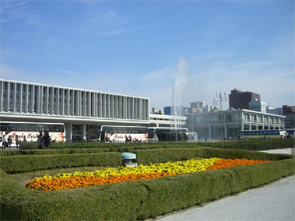
Opening Date
August 24, 1955
Repairing and Rebuilding Dates
Main Building repaired in August 1991
East Building rebuilt in June 1994
Established by
Hiroshima City
Designer
Kenzo Tange, Takashi Asada,Sachio Otani, Norikuni Kimura
Shape
East Building: 3-story building with one basement floor, total floor area 10,098 m2
Main Building: 2-story and partly 3-story building, total floor area 1,615 m2
The Main Building was designed in the pilotis-style so that the space between the land surface and the elevated floor can symbolize the human power to rise from the ashes.
- History of Hiroshima Peace Memorial Museum
- East Building
- Main Building
In September 1949, "the A-bomb Reference Material Display Room" was established in the Hiroshima City Central Community Center. This was the start of the public display of atomic bomb materials. Under the "Hiroshima Peace Memorial City Construction Law," which was promulgated that year, the Peace Memorial Hall was opened in June 1955 and the Peace Memorial Museum in August 1955, in Peace Memorial Park. In June 1994, to improve display and collection functions and provide more space for peace education, Peace Memorial Hall was renovated and integrated into the Peace Memorial Museum. The two facilities are now open as a renewed Hiroshima Peace Memorial Museum.
On July 5, 2006, the Main Building of the Peace Memorial Museum was designated one of the important cultural assets of Japan. This is the first cultural asset from among buildings constructed in the post war period.
In this building, Hiroshima before and after the A-bombing, the background of the A-bombing of Hiroshima, the actual situation of the nuclear age and Hiroshima City's peace efforts are introduced via models, images and photo panels. There is also a video theater where documentary films can be viewed, and on basement floors there are exhibition rooms for paintings of the A-bombing by surviving citizens; halls and meeting rooms where students on school excursions can hear testimonies of A-bombing survivors, and an information reference room where books on the A-bombing and on peace can be viewed.
The main building displays A-bomb artifacts and materials that explain the dreadful powers of heat rays, blast, radiation and the intense heat fires of the A-bombing. These artifacts and materials convey what specifically happened to Hiroshima on August 6, 1945. The facility is also equipped with sections where visitors can view and listen to testimonies of A-bombing survivors, and can write their impressions and messages for peace.